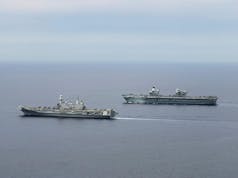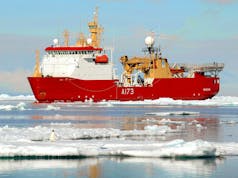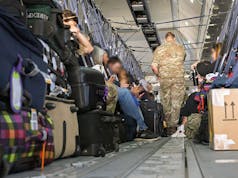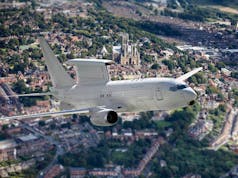Lockheed Martin’s latest generation solid-state radar technology, formerly known as the Solid State Radar (SSR), has been designated as AN/SPY-7(V)1 by the United States government.
The firm say that the designation of AN/SPY-7(V)1 is a direct reflection of the maturity and capability of Lockheed Martin’s solid-state radar technology.
The Japanese Ministry of Defense recently selected AN/SPY-7(V)1 for two planned Aegis Ashore installations in 2018. Additionally, variants of AN/SPY-7(V)1 will be used by the Royal Canadian Navy for the Canadian Surface Combatant programme based on the UK’s Type 26 Frigate and the Spanish Navy for the upcoming F-110.
“Lockheed Martin’s solid state solution meets the mission now and is flexible to adapt to the evolving threats of the future,” said Paul Lemmo, vice president and general manager at Lockheed Martin, in a release.
“This new designation solidifies our ability to provide the most technically advanced capabilities our warfighters require.”
Lockheed say that the AN/SPY-7(V)1 is a modular and scalable solid state radar, allowing for continuous surveillance and protection. It will be fully integrated with the Aegis Combat System.













SPY-7 and T26 will be quite a combination.
Yes but it looks quite large which suggests it will be mounted like tge SPY1 on the superstructure. I still think the T45 Mast with spinning radar is better as it gives that bit extra range to spot hypersonic sea skimmers. However it is good tge USN are moving away from passive electronically scanned like the SPY1 and moving to active electronicaly scanned systems.
With the article in SaveTheRoyalNavy saying that the radar on T31 is going to be the Thales NS100 or NS200, the NS200 at least being (according to DaveyB) a significant step up from Artisan, our use of Artisan on T26 begins to look a bit odd. Surely it will be a bit strange if T31 were to have a significantly more capable radar then T31 wouldn’t it?
I was just thinking the same thought looking at the pictures of PoW coming into Portsmouth. Fantastic news & pics but again it will feel weird to me if even T31 has a better radar than the carrier. What do the USA do there? Apart from AEW aircraft the carrier has the highest point in a CBG for mounting a radar and the greatest stability (I assume) for coping with top weight. Were something to happen to AEW and T45 wouldn’t it make sense for the carrier to have something like Sampson to take over maintaining the picture?
I know that DaveyB has said that high-end radar development is not dead in the U.K. but it’s a critical competency in modern military technology, arguably the most critical competency, so I really hope we do start seeing some evolution of U.K. technology here. My wish list would be twofold…
1 – A next-gen high-end Sampson building further on the current world-class back-end processing but with more antenna flexibility with possibly the option of combining both dual rotating arrays mounted high to maintain radar horizon plus fixed arrays lower to maintain persistent tracks closer to the vessel (which is probably the range when you’re actually guiding an active seeker to a target).
2 – A “Sampson light” derived from the above to compete with and ideally better something like Thales NS200 so that the U.K. can move to the top of the pack again re radar technologies across a wide range of our ships. I know that Artisan isn’t rubbish, it’s still a very good radar, but as other companies and nations are now demonstrating we could and should do better especially for things like T26 and possibly our carriers as well.
Cue DaveyB, just beyond the radar horizon but appearing any minute, or at least I hope so because I’ll be really interested to hear what you (DaveyB) have to say about this stuff.
The carriers also have the S1850M which is a very capable radar (same as the second radar on the T45); it’s a PESA but has been successfully upgraded to AESA for other applications. Anywho, with Artisan as the secondary radar in the case of the carrier, it probably represents better value for money?
As for the T26, I’d rather see them given the NS200 and the Artisan passed down to the T31s. In the end though, both pretty capable at developing the RAP and driving SeaCeptor.
Cheers Julian, no pressure then!
The Thales NS200 uses the research and development the company did on building the AESA version of the Smart L/M (S1850M) radar, so it has pedigree. The antenna size is comparable with the Artisan, hence the comparable range (NS100). However, because it’s an AESA, more power can be generated from the individual transmit/receive modules compared to a PESA. This is because there are no waveguide, pre-amp or coupling losses, which is one of the reasons the NS200 has a longer range. Both the NS200 and Artisan rotate at 30rpm and use a single antenna face, so there’s a rotating blindspot directly behind it. This is where Sampson still has the advantage with its two back to back antenna faces.
I have to be careful now about releasing too much info on Sampson, but expect an upgrade to the antenna soon. Which replaces the modules Galium Arsenide with Gallium Nitride. This has either the advantage of generating more power or the ability to cope with higher power generation for longer without cooling. BAe have said there is also a solid panel version of Sampson waiting in the wings. A lot of development work has been done in the last 10 years. I am really surprised BAe have not released more information.
The issue is that although Sampson is up there with the best. When you are doing intensive target interrogation against background clutter such as looking for sea skimmers it uses up a significant amount of processing power. Basically the maths to separate and filter choppy sea clutter from a real threat is where the money is. By comparison the actual hardware is cheaper. This is one of the primary reasons that the T45 has the S1850, so it can concentrate on searching large volumes of airspace, letting Sampson concentrate on looking for threats trying to sneak in. Sampson is more than capable of doing volume searches, it’s just better at looking and deciphering targets from background clutter compared to the S1850.
HMS Dauntless was in major refit in March this year and had her Sampson overhauled by BAe on the Isle of Wight.
This may be a problem for both the T26 and T31. They both have “one” very capable radar. The problem being is making it do too many jobs and then relying on it being serviceable 24/7. Both ships need a second primary radar. So one can concentrate on volume searching whilst the other looks at the horizon etc. But also allows one to be worked on or allowing for battle damage.
However, worryingly this has come up in the defence select committee questions – see link
https://www.parliament.uk/documents/commons-committees/defence/4%20Chair%20to%20MinDP_defence%20radar.pdf
Its basically BAe saying the Government are not investing in the future of UK radar and need to do something about it. This was raised by the committee, so there should be a record of the Government’s/MoD response.
Thanks for the insights; I was wondering whether there’d been any movement on “Sampson 2.0” as it were. I know it was considered better than AEGIS’ radar when it came into service, but there have been improvements in the American system since then- was wondering how they compared these days.
As you wisely point out, it’s also about the processing at the back end and all of the other parts of the air defence system puzzle. How would you say AEGIS and PAAMS match up in their current forms (if you’re allowed to say?!)? I know it’s a bit like top trumps probably, but I’d still be interested, regardless.
To the best of my knowledge, neither system has been fully tested against a proper swarm attack, simulations yes, but not actual real drone targets. I know HMS Defender did a trial off Scotland where she downed 3 no-notice targets in less than 10 minutes. From memory this was two sea-skimmers and a ballistic target.
The issue here is cost. Clearly to test the system with 100% confidence you need a full complementary of drones to attack the ship using swarming tactics. However, that would mean releasing probably your full inventory of carried missiles. For example, in 2018, Singapore paid MBDA over 650 million euros for 200 Aster 30s, which works out to about 3.25 million per missile. So for a T45 firing off 20 missiles equals 65 million euros, the Treasury will not be happy. The US Navy with a much bigger budget could afford it, but again they only usually test against a small number of drones and rely on simulations.
The Aster/Viper missiles can do both kinetic and proximity kills. There is no reason to fire them as a salvo’d pair as each missile has its own active radar. The main reason for firing in pairs is when you’re using semi-active missiles, which relies on a remote illuminator to light up the target. By having two missiles attacking one target it allows a better chance against a highly manoeuvring target where it’s trying to break the tracking lock. The theory being at least one of the missiles will still get a trackable reflection of the target. By having an active seeker in the missile, it reduces the chances of the target breaking lock but also reduces its reaction time, as the radar generally only goes active around 10km from the target as its being guided by the ship’s search radar.
Technically speaking the T45 should be able to react quicker to Sea-skimmers than most other comparable ships. This is due to Sampson’s greater view-able horizon range compared to say an AEGIS, CEAFAR, APAR or MPAR equipped ship. However, once the target’s above the horizon, the advantages drop off, so reaction times will be similar.
The early AEGIS used SPY1 which was a PESA radar, it is not in the same league as Sampson, especially for clutter rejection. It is extremely powerful and can beam on to a target over 100nm away with a searchlight size beam. However, by doing so means the other three panels are at a very reduced power output. The SPY1 need a vast amount of cooling to cope with the power. The new SPY6 which is an AESA radar is in the same league capability wise as Sampson. However, it can transmit both in the S and X bands. Due to the larger area of the panels, they can transmit more power and would also be more sensitive than Sampson’s two antennas. Therefore, for its given antenna size the SPY6 would have greater above horizon range. The X band will give very good clutter filtering for anything near sea level, whilst the S band will give significant range to the volume search. It will still be slower to react to a T45 as the panels are much lower.
Conversely, the T45 already has an excellent volume search radar in the S1850M. This radar in its Thales (Smart-L/M) guise has been updated to an AESA radar, which has also increased its already impressive range. So perhaps our S1850M will also be updated.
What will the Sampson upgrade do for T45? Will it increase range power? Are there any plans to upgrade the RN’s S1850M’s to active arrays?
Has the T45 been upgraded to track Ballistic missiles yet?
The T45s S1850M has been able to detect ballistic missiles from the start. This was one of the differences to the standard Thales SMART-L radar that it is based on. This was mostly software derived from BAe as the radar is a joint BAe-Thales product. The new SMART-L-MM has used a lot of information gleaned from the S1850M programme. The SMART-L MM has modes that are specifically designed to search for ballistic missiles, however it is now a full AESA radar compared to the S1850M. If the RN decide to get the Aster 30NT for taking out ballistic missiles it would make more sense to convert the radar to AESA which would give it better range and capabilities.
BAe developed an upgrade path for Sampson, one of these was to use a 4 panel array. By using the larger panels more power can be transmitted which equals greater range, but perhaps more importantly it also means the system can be more sensitive. By making it more sensitive it can then “see” smaller stealthier targets.
Thanks Davey. That letter makes pitiful reading. They are begging for £10m of funding over 5 years to keep the UK’s high-end radar capabilities intact. £10m over 5 years??? For such a critical core competency where the U.K. currently has such a good standing??? Against a defence budget of over £40bn per annum??? Surely it shouldn’t require more than a microsecond of thought to get out the chequebook? I really hope HMG comes through on this one.
Correction – £10m over 4 years. Still an inconsequential sum for such a critical area.